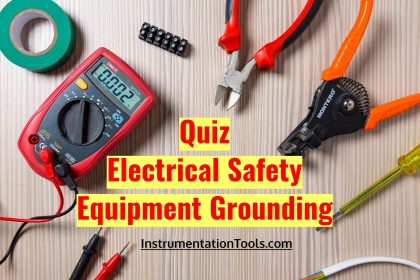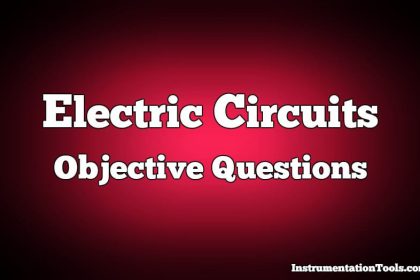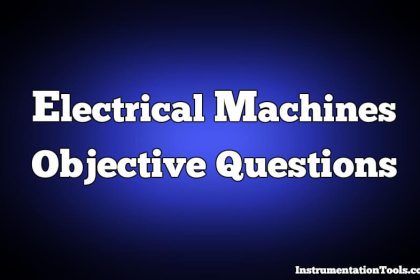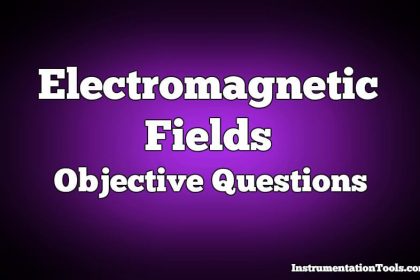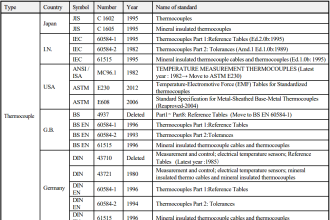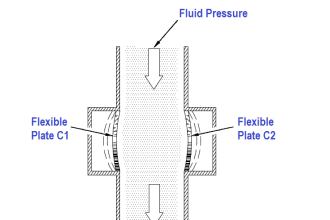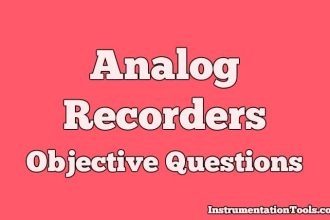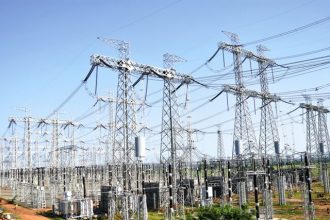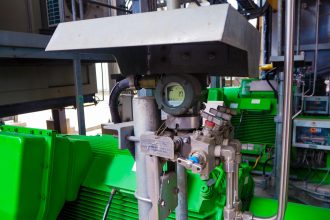In this article, we shared the top 300 electricity and magnetism objective questions and answers for instrumentation, electrical, and electronics engineering students.
Electricity and Magnetism Questions
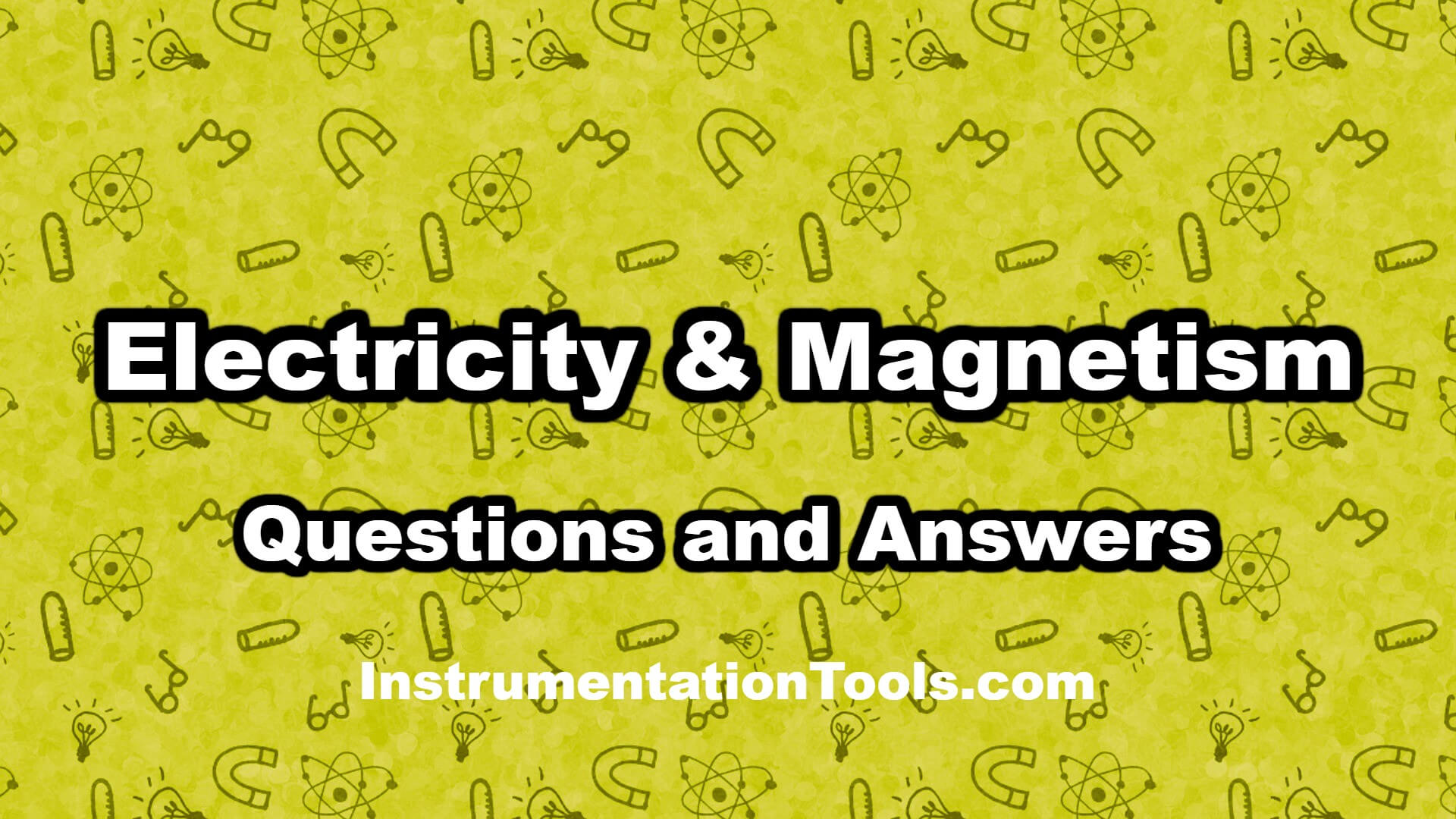
The below list provides all the multiple-choice questions (MCQ) related to electricity and magnetism.
Answers are available at the bottom of the article.
1. Who demonstrated the theory of electromagnetic induction in 1831?
| A) | James Clerk Maxwell |
| B) | Charles Coulomb |
| C) | Andre Ampere |
| D) | Michael Faraday |
2. What solid has no defined crystal structure except perhaps in the arrangement of the nearest neighboring atoms or ions?
| A) | Amorphous |
| B) | Poly- amorphous |
| C) | Polycrystalline |
| D) | Crystalline |
3. The ability of a material to conduct magnetic flux through it.
| A) | Permittivity |
| B) | Reluctivity |
| C) | Conductivity |
| D) | Permeability |
4. If a 20 V potential is applied across a relay coil with 50 turns having of resistance, the total magnetomotive producing magnetic flux in the circuit is
| A) | 1000 A.t |
| B) | 50 T |
| C) | 10 Wb |
| D) | 1000 A t/m |
5. Which of the following materials has the least hysteresis loop area?
| A) | soft iron |
| B) | wrought iron |
| C) | hard steel |
| D) | silicon steel |
6. The lagging effect between flux density of the material and the magnetizing force applied
| A) | Hysteresis |
| B) | Reluctance |
| C) | Eddy current |
| D) | Permeance |
7. Which of the following has the highest permeability?
| A) | Soft iron |
| B) | Steel |
| C) | Permalloy |
| D) | Air |
8. Who demonstrated that there are magnetic effects around every current-carrying conductor and that current-carrying conductors can attract and repel each other just like magnets?
| A) | Luigi Galvani |
| B) | Hans Christian Oersted |
| C) | Charles Coulomb |
| D) | Andre Ampere |
9. If the right handed bottle-opener cork screw is assumed to be along the conductor so as to advance in the direction of current flow, the motion of its handle will indicate the direction of magnetic flux produced around the conductor.
This is known as
| A) | End rule |
| B) | Cork screw rule |
| C) | Left hand rule |
| D) | Right hand rule |
10. The science of adapting electronics to aerospace flight.
| A) | Aerotronics |
| B) | Astrionics |
| C) | Avionics |
| D) | Aerodynamics |
11. Ohm’s law cannot be applied to which material?
| A) | Aluminum |
| B) | Silver |
| C) | Silicon carbide |
| D) | Copper |
12. If the number of valence electrons of an atom is less than 4, then the substance is probably
| A) | a non-metal |
| B) | a metal |
| C) | a semiconductor |
| D) | an insulator |
13. Theory of ferromagnetic phenomena which assumes each atom is a permanent magnet which can turn freely about its center under the influence of applied field and other magnets.
| A) | Oersted’s ferromagnetism theory |
| B) | Ampere’s circuital law |
| C) | Ewing’s theory of ferromagnetism |
| D) | Maxwell’s magnetic theory |
14. The magnetic field around the conductor is determined by the
| A) | Resistance divided by the current |
| B) | Current divided by the resistance |
| C) | Size of the conductor |
| D) | Amount of current |
15. Flux linkages equals
| A) | Flux times number of turns times length of core |
| B) | Flux times number of turns |
| C) | Flux times area of core |
| D) | Flux times number of turns times area of core |
16. Why is it that the magnitude of magnetomotive force required for air gap is much greater than that required for iron part of a magnetic circuit?
| A) | Because air has the lowest relative permeability |
| B) | Because air is a gas |
| C) | Because air is a conductor of magnetic flux |
| D) | Because air has the highest relative permeability |
17. Formed when there exist distant electronic interactions between (opposite) charges present in the neighboring atoms or molecules.
| A) | Covalent bond |
| B) | Van der Waals bond |
| C) | Ionic bond |
| D) | Metallic bond |
18. The ratio between the intensity of magnetization produced in a substance to the magnetizing force producing it
| A) | Magnetic Reluctivity |
| B) | Magnetic conductivity |
| C) | Magnetic susceptibility |
| D) | Magnetic Resistivity |
19. Two similar poles, each 1Wb, placed 1 m apart in air will experience a repulsive force of
| A) | 8 × 1012 N |
| B) | 63000 N |
| C) | 796 kN |
| D) | 63 × 10-13 N |
20. What is the practical unit of electrical energy?
| A) | Megawat-hour |
| B) | Watt |
| C) | Kilowatt-second |
| D) | Kilowatt-hour |
21. Electric potential is a _____ quantity.
| A) | scalar |
| B) | phasor |
| C) | vector |
| D) | variable |
22. The space outside the magnet where its pole have a force of attraction or repulsion on a magnetic pole is called
| A) | Electromagnetic field |
| B) | Magnetic field |
| C) | Free Space Field |
| D) | Electric field |
23. When the relative permeability of a material is slightly more than 1, it is called material.
| A) | ferromagnetic |
| B) | non-magnetic |
| C) | diamagnetic |
| D) | paramagnetic |
24. Define as that pole which when placed in air from a similar and equal pole repels it with a force of newtons
| A) | North pole |
| B) | South pole |
| C) | Unit pole |
| D) | Magnetic pole |
25. How much is the flux in Weber in the above problem?
| A) | 2 x 103 |
| B) | 2 x 10-3 |
| C) | 2 x 10-5 |
| D) | 2 x 105 |
26. When a current carrying conductor is placed in a magnetic field, the maximum force will act on the conductor when the conductor is at an angle of _____ to the magnetic field.
| A) | 30 deg C |
| B) | 90 deg C |
| C) | 60 deg C |
| D) | 45 deg C |
27. Who discovered that a current-carrying conductor would move when placed in a magnetic field?
| A) | Michael Faraday |
| B) | Gustav Robert Kirchhoff |
| C) | Andre Ampere |
| D) | Hans Christian Oersted |
28. The simplest type of atom to exist is the _____ atom.
| A) | Hydrogen |
| B) | Boron |
| C) | Oxygen |
| D) | Helium |
29. If the value of α25 a conductor is 1/255 per oC , then the value of α20 is
| A) | 1/230 per oC |
| B) | 1/300 per oC |
| C) | 1/250 per oC |
| D) | 1/260 per oC |
30. The resistivity of a conductor _____ with an increase in temperature.
| A) | none of the answers |
| B) | decreases |
| C) | becomes zero |
| D) | increases |
31. Refers to the non-metallic materials that have the ferromagnetic properties of iron.
| A) | Diamagnetic |
| B) | Ferromagnetic |
| C) | Paramagnetic |
| D) | Ferrites |
32. A current if flowing east along a power line. if the earth’s field is neglected, the direction of the magnetic field below it is
| A) | West |
| B) | North |
| C) | South |
| D) | East |
33. What is the typical saturation flux density for most magnetic materials?
| A) | 1 Wb/m2 |
| B) | 4 Wb/m2 |
| C) | 5 Wb/m2 |
| D) | 2 Wb/m2 |
34. The uncharged particles which have no effect on its atomic charge.
| A) | Neutrons |
| B) | Nucleons |
| C) | Protons |
| D) | Electrons |
35. What principle states that each electron in an atom must have a different set of quantum numbers?
| A) | Quantum principle |
| B) | Inclusion principle |
| C) | Electron principle |
| D) | Exclusion principle |
36. A magnetic circuit carries a flux θi in the iron part and a flux θg in the air gap. What is the leakage coefficient?
| A) | θi + θg |
| B) | θi x θg |
| C) | θi / θg |
| D) | θg / θi |
37. Which of the following materials has the highest dielectric strength?
| A) | Mica |
| B) | Glass |
| C) | Oiled paper |
| D) | Air |
38. Back emf refers to the
| A) | Current equal to the applied emf |
| B) | Current opposing the applied emf |
| C) | Opposing emf |
| D) | Voltage opposing the applied emf |
39. One weber of flux is equal to _____ magnetic lines of force.
| A) | 1010 |
| B) | 108 |
| C) | 107 |
| D) | 106 |
40. Referred to as the specific reluctance of a material
| A) | Resistivity |
| B) | Conductivity |
| C) | Permeability |
| D) | Reluctivity |
41. Electronic current in a wire is the flow of _____ electrons.
| A) | loose |
| B) | valence |
| C) | bound |
| D) | free |
42. This paper does not exhibit electricity because it contains the same number of
| A) | neutrons and electrons |
| B) | atoms |
| C) | protons and electrons |
| D) | neutrons and positrons |
43. Electric field intensity is measured in
| A) | Newton/meter |
| B) | Amperes/meter |
| C) | Newton-meter |
| D) | volts/meter |
44. Three charges of +5 C, -6 C and +9 C are placed inside a sphere. What is the total flux passing through the surface of sphere?
| A) | 8 C |
| B) | -6 C |
| C) | 14 C |
| D) | 20 C |
45. Hysteresis refers to the _____ magnetizing force applied.
| A) | Leading effect |
| B) | Lagging effect |
| C) | Ratio |
| D) | Equality |
46. The reluctance of a magnetic circuit varies with
| A) | length × area |
| B) | length + area |
| C) | area ÷ length |
| D) | length ÷ area |
47. A law establishing the fact that the algebraic su of the rises and drops of the mmf around a closed loop of a magnetic circuit is equal to zero.
| A) | Kirchhoff’s circuital law |
| B) | Ampere’s circuital law |
| C) | Maxwell’s circuital law |
| D) | Coulomb’s circuital law |
48. A substance that attracts pieces iron
| A) | Magnet |
| B) | All of the answers |
| C) | Conductor |
| D) | Semiconductor |
49. The electric field intensity between the parallel plate air capacitor is 20 N/C. If an insulating slab of relative permittivity 5 is placed between the plates, then electric field intensity will be
| A) | 20 N/C |
| B) | 40 N/C |
| C) | 100 N/C |
| D) | 4 N/C |
50. What is the unit of magnetomotive force?
| A) | Ampere- turn |
| B) | Weber |
| C) | Tesla |
| D) | Volt |
51. When a conductor is stationary and the magnetic field is moving or changing the emf induced is called
| A) | Self induced emf |
| B) | Mutually induced emf |
| C) | Dynamically induced emf |
| D) | Statically induced emf |
52. The magnetic flux through a wire loop in a magnetic field does not depend on
| A) | The area of the loop |
| B) | The magnitude of the field |
| C) | The shape of the loop |
| D) | The angle between the plane of the loop and the direction |
53. One electron volt (1 eV) is equivalent to _____ joules
| A) | 1.3 x 10-19 |
| B) | 1.4 x 10-19 |
| C) | 1.6 x 10-19 |
| D) | 1.5 x 10-19 |
54. The emf induced in a coil due to the change of its own flux linked with it is called
| A) | Dynamically induced emf |
| B) | Mutually induced emf |
| C) | Self induced emf |
| D) | Statically induced emf |
55. Electric field intensity at a point due to a given charge _____ if the relative permittivity of the medium decreases.
| A) | decreases |
| B) | remains unchanged |
| C) | increases |
| D) | becomes zero |
56. Hysteresis loss can be reduced by one of the following.
| A) | Laminating the magnetic circuit |
| B) | Using material narrow hysteresis loop |
| C) | Increasing mmf of the circuit |
| D) | Using ferromagnetic core |
57. One that has magnetic poles produced by internal atomic structure with no external current necessary
| A) | Diamagnetic |
| B) | Permanent magnets |
| C) | Electromagnetic |
| D) | Paramagnetic |
58. Core materials of a good relay have _____ hysteresis loop.
| A) | large |
| B) | very narrow |
| C) | narrow |
| D) | very large |
59. What is used as the insulating material or dielectric in an electric ion?
| A) | Mica |
| B) | Titanate compound |
| C) | Oiled paper |
| D) | Paraffin |
60. The quantity 106 maxwells is equivalent to one
| A) | Weber |
| B) | Gauss |
| C) | Gilbert |
| D) | Tesla |
61. One ampere- turn is equivalent to _____ gilberts
| A) | 1.26 |
| B) | 1.16 |
| C) | 1.46 |
| D) | 1.36 |
62. Electromotive force in a circuit
| A) | maintains circuit resistance |
| B) | is needed to make the circuit complete |
| C) | increases the circuit resistance |
| D) | causes free electrons to flow |
63. A negative ion results when an atom gains an additional
| A) | Proton |
| B) | Neutron |
| C) | Electron |
| D) | Atom |
64. When the current flows, the magnetic field ……. conductor is in what direction?
| A) | Opposite the current direction |
| B) | Omnidirectional |
| C) | The same as the current direction |
| D) | In the direction determined by the left hand rule |
65. Calculate the flux density that will be produced by the field intensity of 2000 a. t/m for a permeability of 126 x 10-6 T/A.t/m
| A) | 0.252 T |
| B) | 0.252 x 10-2 G |
| C) | 0.252 G |
| D) | 0.252 x 10-2 T |
66. A magnetic field is
| A) | The current flow through space around a permanent magnet |
| B) | The force between the plates of a charged capacitor |
| C) | The force set up when current flows through a conductor |
| D) | The force that drives current through a resistor |
67. When the relative permeability of a material is much greater than 1, it is called material.
| A) | non-magnetic |
| B) | paramagnetic |
| C) | diamagnetic |
| D) | ferromagnetic |
68. The phenomenon that when an electric current passes through an anisotropic crystal, there is an absorption or liberation of heat due to the non-uniformity in current distribution.
| A) | Dember effect |
| B) | Bridgman effect |
| C) | Corona effect |
| D) | Destriau effect |
69. What is the unit of reluctance?
| A) | Maxwell |
| B) | Weber |
| C) | Gauss |
| D) | At/Wb |
70. A factor used to correct for the electrostatic forces of the more distant ions in an ionic solid.
| A) | Madelung constant |
| B) | Avogadro’s number |
| C) | Boltzmann’s constant |
| D) | Planck’s constant |
71. The air space between poles of magnets
| A) | Atmosphere |
| B) | Air Gap |
| C) | Vacuum |
| D) | Free space |
72. Materials that have very high permeabilities (hundreds and even thousand times of that of free space)
| A) | Non- magnetic |
| B) | Paramagnetic |
| C) | Diamagnetic |
| D) | Ferromagnetic |
73. The phenomenon by which a subtracts pieces of iron
| A) | Electromagnetism |
| B) | Naturalism |
| C) | Magnetism |
| D) | Materialism |
74. Which of the following statements is TRUE?
| A) | The valence electrons are located in the nucleus of an atom |
| B) | For conductors, the valence electron are strongly attracted to the nucleus |
| C) | The current carriers in conductors are valence electrons |
| D) | Silicon dioxide is a good |
75. The reluctance of the magnetic circuit is ______ relative permeability of the material comprising the circuit.
| A) | independent of |
| B) | dependent of |
| C) | directly proportional to |
| D) | inversely proportional to |
76. A law stating that the magnetic susceptibilities of most paramagnetic substances are inversely proportional to their absolute temperatures.
| A) | Child’s Law |
| B) | CR Law |
| C) | Curie’s Law |
| D) | Curie-Weiss Law |
77. What is the reluctance of a magnetic path having a length of and cross-sectional area of 2 x 10-3 m2?
| A) | 6366 A.t/Wb |
| B) | 6000 A.t/Wb |
| C) | 8 x 10-3 A.t/Wb |
| D) | 0.8 A.t/Wb |
78. The diameter of a hydrogen atom is approximately _____ cm.
| A) | 1.1 x 10-9 |
| B) | 1.1 x 10-8 |
| C) | 1.1 x 10-7 |
| D) | 1.1 x 10-6 |
79. The conduction of electricity across the surface of a dielectric is called
| A) | surface effect |
| B) | creepage |
| C) | skin effect |
| D) | crosstalk |
80. What is another name for relative permittivity?
| A) | Electric intensity |
| B) | Dielectric constant |
| C) | Potential gradient |
| D) | Dielectric strength |
81. The emission of electrons from hot bodies is called
| A) | Skin effect |
| B) | Edison effect |
| C) | Half effect |
| D) | Radiation effect |
82. If the solenoid is gripped by the right hand with the fingers pointing the direction of current flow, the outstretched thumb will then point the north pole. This is known as
| A) | Right hand rule |
| B) | Helix rule |
| C) | Cork screw rule |
| D) | End rule |
83. The temperature coefficient of resistance of eureka is
| A) | negative |
| B) | infinite |
| C) | almost zero |
| D) | positive |
84. Used to maintain strength of magnetic field
| A) | Air gap |
| B) | Container |
| C) | Keeper |
| D) | Source |
85. Which of the following is used by permanent magnets as the magnetic material?
| A) | nickel |
| B) | hardened steel |
| C) | iron |
| D) | soft steel |
86. A 6- V battery is connected across a solenoid of 100 turns having a resistance of 2 ohms, Calculate the number of ampere-turns?
| A) | 50 |
| B) | 300 |
| C) | 600 |
| D) | 100 |
87. The force of attraction or repulsion between two magnetic poles is directly proportional to their strengths.
| A) | Newton’s first law |
| B) | Coulomb’s second law |
| C) | Faraday’s first law of electromagnetic induction |
| D) | Coulomb’s first law |
88. A positively charged body has
| A) | excess of neutrons |
| B) | deficit of electrons |
| C) | deficit of protons |
| D) | excess of electrons |
89. A magnetic flux of 2.5 x 104 Wb through an area of 5 x 104 square meters results in
| A) | 5000 Tesia of flux density |
| B) | 0.5 Tesia of flux density |
| C) | 5 Wb |
| D) | 2.5 x 10-5 Wb of flux |
90. The electric flux density is a ______ quantity.
| A) | scalar |
| B) | variable |
| C) | vector |
| D) | phasor |
91. If the value of α25 of a conductor is 1/230 per oC, then the value of α20 is
| A) | 1/230 per oC |
| B) | 1/180 per oC |
| C) | 1/280 per oC |
| D) | 1/150 per oC |
92. Lenz’s law is the consequence of the law of conservation of
| A) | Momentum |
| B) | Energy |
| C) | Field lines |
| D) | Charge |
93. The relation between absolute permittivity of air (ε0), absolute permeability of air (µ0) and velocity of light (c) is given by
| A) | µ0 ε0 = C2 |
| B) | µ0 ε0 = C |
| C) | 1 / µ0 ε0 = C |
| D) | =1 / µ0 ε0 = C2 |
94. Which of the following electric quantities is vector in character?
| A) | Charge |
| B) | Energy |
| C) | Potential Difference |
| D) | Field |
95. Permeance of a magnetic circuit is _____ the cross-sectional area of the circuit.
| A) | directly proportional to |
| B) | inversely proportional to |
| C) | dependent of |
| D) | independent of |
96. Temporary magnets are commonly employed in
| A) | magnetos |
| B) | moving coils loudspeakers |
| C) | motors |
| D) | electric instruments |
97. The idea of preventing one component from affecting another through their common electric and magnetic field is referred to as
| A) | Hall effect |
| B) | Limiting |
| C) | Shielding |
| D) | Grounding |
98. The force between two magnetic poles is _____ the relative permeability of the medium.
| A) | independent of |
| B) | equal to |
| C) | directly proportional to |
| D) | inversely proportional to |
99. Which of the following is a natural magnet?
| A) | Soft iron |
| B) | Lodestone |
| C) | Steel |
| D) | Magnesia |
100. The B-H curve for ______ is a straight line passing through the origin.
| A) | air |
| B) | cobalt |
| C) | soft iron |
| D) | hardened steel |
101. A law that states that the polarity of the induced voltage will oppose the change in magnetic flux causing the induction.
| A) | Joule’s law |
| B) | Faraday’s law |
| C) | Lenz’ law |
| D) | Coulomb’s law |
102. Which of the following is a vector quantity?
| A) | Flux density |
| B) | Magnetic permeability |
| C) | Magnetic potential |
| D) | Magnetic field intensity |
103. Residual magnetism refers to the flux density, which exists in the iron core when the magnetic field intensity is
| A) | Unity |
| B) | Maximize |
| C) | Reduced to zero |
| D) | Minimized |
104. When the relative permeability of a material is slightly less than 1, it is called material.
| A) | diamagnetic |
| B) | non-magnetic |
| C) | ferromagnetic |
| D) | paramagnetic |
105. The K shell or the first shell has how many permissible number of orbiting electrons?
| A) | 3 |
| B) | 2 |
| C) | 4 |
| D) | 1 |
106. It is the reciprocal of reluctance and implies the case of readiness with which magnetic flux is developed.
| A) | Resistance |
| B) | Permeance |
| C) | Inductance |
| D) | Conductance |
107. The force acting on a pole of 5 Wb is 25 N. What is the intensity of the magnetic field?
| A) | 5 N/Wb |
| B) | 25 N/Wb |
| C) | 125 N/Wb |
| D) | 0.2 N/Wb |
108. The force which set ups or tends to set up magnetic flux in a magnetic circuit
| A) | Potential difference |
| B) | Electromotive force |
| C) | Magnetomotive force |
| D) | Dynamic force |
109. The direction of force o a current carrying conductor placed in a magnetic field can be found by
| A) | Fleming’s left hand rule |
| B) | using a compass |
| C) | Fleming’s right hand rule |
| D) | Cork screw rule |
110. If the resistance of a material 2 m long and 2 m2 in area of cross-section is 1.6 × 10-8 ohms, then its resistivity is
| A) | 3.2 × 10-8 ohm-m |
| B) | 0.16 × 10-8 ohm-m |
| C) | 0.64 × 10-8 ohm-m |
| D) | 1.6 × 10-8 ohm-m |
111. One coulomb of charge consists of ______ electrons.
| A) | 6.24 × 1016 |
| B) | 624 × 1016 |
| C) | 62.4 × 1016 |
| D) | 0.624 × 1016 |
112. The force between two charges placed a given distance apart _____ as the relative permittivity of the medium is increased.
| A) | increases |
| B) | decreases |
| C) | remains unchanged |
| D) | becomes infinite |
113. The electrons in the last orbit of an atom are called ______ electrons.
| A) | free |
| B) | thermionic |
| C) | valence |
| D) | bound |
114. The evaporation of electrons from a heated surface is called
| A) | Convection |
| B) | Conduction |
| C) | Radiation |
| D) | Thermionic emission |
115. The unit of flux is ______ in cgs system.
| A) | Maxwell |
| B) | Oersted |
| C) | Tesia |
| D) | Gilbert |
116. If the number of valence electrons of an atom is exactly 4, then the substance is called
| A) | a conductor |
| B) | a cryogenic conductor |
| C) | a semiconductor |
| D) | an insulator |
117. The core of a transformer heats up when its primary is fed from an ac source because of
| A) | reluctance of core |
| B) | ferromagnetism |
| C) | permeability |
| D) | hysteresis loss |
118. The magnetic field of a magnetized iron bar when strongly heated
| A) | is unchanged |
| B) | Becomes weaker |
| C) | Reverses in direction |
| D) | Becomes stronger |
119. What bond is formed when electrons in the outermost energy orbits of the atoms are shared between two or more electrons?
| A) | Van der Waals |
| B) | Covalent |
| C) | Metallic |
| D) | Ionic |
120. The magnetic flux of 2000 lines is how many Maxwells?
| A) | 1000 |
| B) | 4000 |
| C) | 8000 |
| D) | 2000 |
121. Defined as the ratio of the volume occupied by the atoms or ions in a unit cell divided by the volume of the unit cell and is used to measure the compactness of a crystal.
| A) | Ionic compacting ratio (ICR) |
| B) | Atomic compacting factor (ACF) |
| C) | Atomic packing factor (APF) |
| D) | Ionic Packing Ratio (IPR) |
122. What is the measure of the density and sign of the electric charge at a point relative to that at some time?
| A) | Electric current |
| B) | Electric potential |
| C) | Electric charge |
| D) | Electric intensity |
123. The force between two magnetic poles varies with the distance between them. The variation is _______ to the square of that distance.
| A) | Inversely proportional |
| B) | Greater than |
| C) | Equal |
| D) | Directly proportional |
124. One of the solid structures in which the position of the atoms or ions are predetermined
| A) | Polycrystalline solid |
| B) | Amorphous solid |
| C) | Crystalline Solid |
| D) | Poly- amorphous solid |
125. If the relative permittivity of a material is 10, then its permittivity is
| A) | 4n × 10-7 F/m |
| B) | 8.854 ×1011 F/m |
| C) | 8.854 ×1012 F/m |
| D) | 4n ×10-6 F/m |
126. A magnetizing force of 1000 AT/m will produce a flux density of ______ in air.
| A) | 1.257 mWbm2 |
| B) | 0.63 mWbm2 |
| C) | 0.63 mWbm2 |
| D) | 1.257 mWbm2 |
127. What bond is formed when one or more electrons in the outermost energy orbit of an atom are transferred to another?
| A) | Ionic |
| B) | Metallic |
| C) | Van der Waals |
| D) | Covalent |
128. A length of wire has a resistance of 10 ohms. What is the resistance of a wire of the same material three times as long and twice the cross-sectional area?
| A) | 30 ohms |
| B) | 20 ohms |
| C) | 15 ohms |
| D) | 7 ohms |
129. The greater percentage of materials is .
| A) | paramagnetic |
| B) | non-magnetic |
| C) | ferromagnetic |
| D) | diamagnetic |
130. All matters (gas, liquid and solid) are composed of
| A) | Neutrons |
| B) | Atoms |
| C) | Particles |
| D) | Electrons |
131. Which of the following is used by temporary magnets as the magnetic material?
| A) | Hardened steel |
| B) | Soft iron |
| C) | Cobalt steel |
| D) | Tungsten steel |
132. How is mutual inductance between two coils decreased?
| A) | By using a common core |
| B) | By moving the coils apart |
| C) | By increasing the number of turns of either coil |
| D) | By moving the coils closer |
133. What is the maximum number of electrons that can be accommodated in the last orbit of an atom?
| A) | 8 |
| B) | 2 |
| C) | 4 |
| D) | 18 |
134. Who discovered the relationship between magnetism and electricity that serves as the foundation for the theory of electromagnetism?
| A) | Hans Christian Oersted |
| B) | Andre Ampere |
| C) | Luigi Galvani |
| D) | Charles Coulomb |
135. The mass of a proton is ______ the mass of an electron.
| A) | equal to |
| B) | about 1837 times |
| C) | less than |
| D) | 200 times |
136. The emf induced in a coil due to the changing current of another neighboring coil is called
| A) | Statically induced emf |
| B) | Self induced emf |
| C) | Mutually induced emf |
| D) | Dynamically induced emf |
137. The physical motion resulting from the forces of magnetic fields is called
| A) | Rotation |
| B) | Torque action |
| C) | Repulsion |
| D) | Motor action |
138. The unit of electrical energy is
| A) | Watt- second |
| B) | Kilowatt-hour |
| C) | Joule |
| D) | All of the answers |
139. Magnetic intensity is a
| A) | Phasor quantity |
| B) | Physical quantity |
| C) | Vector quantity |
| D) | Scalar quantity |
140. All magnetic field originates from
| A) | Magnetic domain |
| B) | moving electric charge |
| C) | Permanent magnets |
| D) | Iron atoms |
141. If the magnetic material is located within a coil through which alternating current (60 Hz frequency) flows, then _______ hysteresis loops will be formed every second.
| A) | 180 |
| B) | 30 |
| C) | 120 |
| D) | 60 |
142. An effect which is generally used in the gausameter to measure flux density.
| A) | Skin effect |
| B) | Hall effect |
| C) | Magnetic effect |
| D) | Flywheel effect |
143. Hydrogen is an example of a ______ material.
| A) | Ferromagnetic |
| B) | Non- magnetic |
| C) | Diamagnetic |
| D) | Paramagnetic |
144. The magnitude of the induced emf in a coil is directly proportional to the rate of change of flux linkages. This is known as
| A) | Faraday’s first law of electromagnetic induction |
| B) | Coulomb’s Law |
| C) | Joule’s Law |
| D) | Faraday’s second law of electromagnetic induction |
145. The core of a magnetic equipment uses a magnetic material with
| A) | Least permeability |
| B) | Low permeability |
| C) | High permeability |
| D) | Moderate permeability |
146. The energy stored in an electrostatic field or electromagnetic field is called
| A) | Kinetic energy |
| B) | Potential energy |
| C) | Electromagnetic energy |
| D) | Rest energy |
147. Permanent magnets can be found in
| A) | earphones |
| B) | dynamic loudspeakers |
| C) | relays |
| D) | electric bells |
148. The hot resistance of an incandescent lamp is about ______ its cold resistance.
| A) | 5 times |
| B) | 10 times |
| C) | 100 times |
| D) | 50 times |
149. The force between two magnetic poles is _____ their pole strengths.
| A) | the sum of |
| B) | inversely proportional to |
| C) | the product of |
| D) | directly proportional to |
150. An atom or a group of atoms that carries a net electric charge.
| A) | Positive ion |
| B) | Electron |
| C) | Negative ion |
| D) | Ion |
151. When the ferromagnetic substance is inserted in a current-carrying solenoid, the magnetic field is
| A) | Slightly increased |
| B) | Greatly increased |
| C) | Slightly decreased |
| D) | Greatly decreased |
152. Electron is a Greek word for
| A) | amber |
| B) | Heat |
| C) | Fire |
| D) | Stone |
153. The temperature coefficient of resistance of semiconductors is
| A) | infinite |
| B) | zero |
| C) | negative |
| D) | positive |
154. Which of the following is a paramagnetic material?
| A) | Carbon |
| B) | Copper |
| C) | Oxygen |
| D) | Bismuth |
155. The magnetic field inside a solenoid
| A) | decreases with distance from the axis |
| B) | is zero |
| C) | is uniform |
| D) | increases with distance from the axis |
156. What is the relative permittivity of air?
| A) | 1 |
| B) | 8.854 × 10-12 |
| C) | 0 |
| D) | 4π × 10-7 |
157. Ohm’s law can be used only to a _____ circuit or component.
| A) | Trivalent |
| B) | Unilateral |
| C) | Exponential |
| D) | Linear |
158. The B-H curve of _____ is not a straight line.
| A) | silicon steel |
| B) | air |
| C) | wood |
| D) | soft iron |
159. What is the main advantage of temporary magnets?
| A) | The magnetic flux can be changed |
| B) | Abundance of ferromagnetic material that can be temporarily magnetized. |
| C) | Hysteresis can be decreased. |
| D) | Magnetic materials can be used. |
160. A group of magnetically aligned atoms is called
| A) | Range |
| B) | Domain |
| C) | Crystal |
| D) | Lattice |
161. Electric lines of force leave or enter the charge surface at an angle of
| A) | 300 |
| B) | 900 |
| C) | depending upon the angle of launch and entry |
| D) | 450 |
162. Bonding of atoms that is due to the force of attraction between positive ions and a group of negative ions
| A) | Metallic bond |
| B) | Ionic bond |
| C) | Electrostatic Bond |
| D) | Covalent Bond |
163. In electro-mechanical conversion devices like generators and motors the reason why a small air gap is left between the rotor and stator is to
| A) | decrease the reluctance of magnetic path |
| B) | complete the magnetic path |
| C) | permit mechanical clearance |
| D) | increase flux density in air gap |
164. The magnetic materials should have a large hysteresis loss for one of the following applications.
| A) | Permanent Magnets |
| B) | AC motors |
| C) | Transformers |
| D) | DC generators |
165. The induced emf in a wire loop that is moved parallel to a uniform magnetic field is
| A) | Dependent on the magnitude of the field |
| B) | Dependent on the area of the loop |
| C) | Dependent on the shape of the loop |
| D) | Zero |
166. An alloy of 22 percent iron and 78 per cent nickel.
| A) | Constantan |
| B) | Permalloy |
| C) | Alnico |
| D) | Manganin |
167. What is the usual value of leakage coefficient for electrical machines?
| A) | 5 to 10 |
| B) | 0.5 to 1 |
| C) | 1 to 5 |
| D) | 1.15 to 1.25 |
168. What determines the value of the temperature coefficient of resistance of a material?
| A) | cross-sectional area |
| B) | length |
| C) | volume |
| D) | nature and temperature |
169. If the value of α0 a conductor is 1/234 per oC, then the value of α18 is
| A) | 1/272 per 0C |
| B) | 1/273 per 0C |
| C) | 1/218 per 0C |
| D) | 1/252 per 0C |
170. Which of the following has the least number of valence electrons?
| A) | Insulator |
| B) | Semiconductor |
| C) | Semi- insulator |
| D) | Conductor |
171. Refers to the magnetic lines
| A) | Magnetomotive force |
| B) | Current |
| C) | Hysteresis |
| D) | Flux |
172. The relative permeability of a magnetic material is 105. What is its permeability?
| A) | 4π × 10-7 H/m |
| B) | 4π × 10-12 H/m |
| C) | 4π × 10-2 H/m |
| D) | 4π × 107 H/m |
173. The electric potential across part AB of a circuit is 5 V; point A being at higher potential. If a charge of 5 C moves from A to B, then energy released as
| A) | 100 joules |
| B) | 25 joules |
| C) | 5 joules |
| D) | 10 joules |
174. The flux density in an air-cored coil is 10-3 Wb/m2.
With a cast iron core of relative permeability 100 inserted, the flux density will become
| A) | 10-3 Wb/m2 |
| B) | 103 Wb/m2 |
| C) | 10-2 Wb/m2 |
| D) | 10-1 Wb/m2 |
175. A one cubic cm of copper has how many free electrons at room temperature?
| A) | 80 × 1018 |
| B) | 20 × 1010 |
| C) | 50 × 1020 |
| D) | 8.5 x 1022 |
176. The point in a magnet where the intensity of magnetic lines of force is maximum
| A) | North pole |
| B) | South pole |
| C) | Unit pole |
| D) | Magnetic pole |
177. The electric potential at a point in air due to a charge is 21 V. If the air is replaced by a medium of relative permittivity of 3, then electric potential at that point will be
| A) | 21 V |
| B) | 42 V |
| C) | 7 V |
| D) | 63 V |
178. A 200-watt lamp working for 24 hours will consume approximately _____ units.
| A) | 50 |
| B) | 5 |
| C) | 0.5 |
| D) | 24 |
179. The net electrical charge in an isolated system remains constant. This is known as
| A) | Coulomb’s second law |
| B) | Law of conservation of energy |
| C) | Law of conservation of charge |
| D) | Coulomb’s first law |
180. Under ordinary conditions, a body is considered
| A) | positively charged |
| B) | neutral |
| C) | negatively charged |
| D) | stable |
181. Defined as the number of lines per unit area through any substance in a plane at right angles to the lines of force
| A) | Flux |
| B) | Flux lines |
| C) | Flux density |
| D) | Flux intensity |
182. Magnetic effects of the earth as a huge magnet with north and south poles.
| A) | Terrestrial magnetism |
| B) | Terrestrial ferromagnetism |
| C) | Ferromagnetic |
| D) | Diamagnetic |
183. When a wire loop is rotated in a magnetic field the direction of the induced emf changes one in every ____ revolution
| A) | 1/3 |
| B) | 1/4 |
| C) | 1/2 |
| D) | 2/3 |
184. What is the SI unit of conductance?
| A) | Ohms |
| B) | Mhos |
| C) | 1/Ohms |
| D) | Siemens |
185. Hipernik is an alloy containing ______ iron and ______ nickel.
| A) | 50% ; 50% |
| B) | 70% ; 30% |
| C) | 40% ; 60% |
| D) | 60% ; 40% |
186. A theorem which states that an electric current flowing in a circuit produces a magnetic field at external points equivalent to that due to a magnetic shell whose bounding edge is the conductor and whose strength of the current.
| A) | Faraday’s law |
| B) | Joule’s law |
| C) | Ampere’s theorem |
| D) | Volta’s theorem |
187. Which of the following materials has permeability slightly less than that of free space?
| A) | Non- magnetic |
| B) | Ferromagnetic |
| C) | Paramagnetic |
| D) | Diamagnetic |
188. The total number of magnetic lines of force in a magnetic field is called
| A) | Magnetic flux density |
| B) | Magnetic flux intensity |
| C) | Magnetic potential |
| D) | Magnetic flux |
189. The tiniest element of matter
| A) | Proton |
| B) | Electron |
| C) | Neutron |
| D) | Atom |
190. The ratio of the permeability of the material to the permeability of air or vacuum.
| A) | Relative permittivity |
| B) | Relative permeability |
| C) | Relative conductivity |
| D) | Relative reluctivity |
191. What is the diameter of an atom?
| A) | About 10-10 mm |
| B) | About 10-10 mm |
| C) | About 10-10 cm |
| D) | About 10-10 µm |
192. If two similar charges 1 coulomb each are placed 1 m apart in air, then the force of repulsion is
| A) | 9 × 109 N |
| B) | 5 × 106 N |
| C) | 8 × 106 N |
| D) | 106 N |
193. Another term for corona discharge.
| A) | Corona Effect |
| B) | Lightning |
| C) | Sparking |
| D) | Aurora |
194. If the distance between two magnetic poles decreases by 2 times, the force between them
| A) | increases two times |
| B) | increases four times |
| C) | decreases four times |
| D) | decreases two times |
195. A test charge means a charge of
| A) | +1 C |
| B) | -20 C |
| C) | 1 electron |
| D) | -1 C |
196. Which element has four valence electrons?
| A) | Insulator |
| B) | Semi- insulator |
| C) | Semiconductor |
| D) | Conductor |
197. Calculate the permeability (in T/A. t/m) of a magnetic material that has a relative permeability of 300
| A) | 3.78 x 10-6 |
| B) | 3.78 x 10-5 |
| C) | 3.78 x 10-4 |
| D) | 3.78 x 10-3 |
198. If a magnetic flux cuts across 200 turns at a rate of 2Wb/s, the induced voltage according to Faraday’s law is about
| A) | 200 V |
| B) | 400 V |
| C) | 600 V |
| D) | 100 V |
199. Who discovered superconductivity in 1911?
| A) | Charles Coulomb |
| B) | Geory Bednorz |
| C) | Alex Muller |
| D) | Kamerlingh Onnes |
200. One of the common application of an air- cored choke.
| A) | Radio frequency |
| B) | Power supply |
| C) | Audio frequency |
| D) | Power transformer |
201. The amount of magnetizing force to counter balance the residual magnetism of a magnetic material is referred to as
| A) | Retentivity |
| B) | Reluctivity |
| C) | Coercivity |
| D) | Susceptivity |
202. At/m is a unit of
| A) | magnetic force |
| B) | reluctance |
| C) | mmf |
| D) | magnetic flux density |
203. ______ is a substance of whose molecules consist of the same kind of atom.
| A) | Element |
| B) | Compound |
| C) | Isotope |
| D) | Mixture |
204. What is used as the dielectric material in high voltage transformers?
| A) | Mica |
| B) | Oiled paper |
| C) | Paraffin |
| D) | Porcelain |
205. A permanent magnet does not exert a force on
| A) | a stationary electric charge |
| B) | an unmagnetized iron bar |
| C) | a moving electric charge |
| D) | a magnetized iron bar |
206. Magnetic fields do not interact with
| A) | Stationary electric charges |
| B) | Moving permanent magnets |
| C) | Stationary permanent magnets |
| D) | Moving electric charges |
207. Which of the following is a paramagnetic material?
| A) | Copper |
| B) | Oxygen |
| C) | Carbon |
| D) | Bismuth |
208. The force between two magnetic poles is _____ their poles strength.
| A) | equal to |
| B) | directly proportional to |
| C) | directly proportional to the square root of |
| D) | inversely proportional to |
209. What is the SI unit of specific resistance or resistivity?
| A) | Ohm-cm |
| B) | Ohm-circular mil per foot |
| C) | Ohm-m |
| D) | Ohm-circular mil per inch |
210. How many electrons are needed in the valence orbit to give a material’s stability?
| A) | 8 |
| B) | 5 |
| C) | 6 |
| D) | 4 |
211. The permeability of permalloy is
| A) | Slightly greater than the permeability of air |
| B) | Equal to the permeability of air |
| C) | Slightly less than permeability of air |
| D) | Very much greater than permeability of air |
212. The dielectric constant of most materials lies between
| A) | 50 and 100 |
| B) | 1 and 10 |
| C) | 20 and 50 |
| D) | 10 and 20 |
213. Which of the following magnetic materials can be easily magnetized in both directions?
| A) | High hysteresis loss materials |
| B) | Low hysteresis loss materials |
| C) | Hard magnetic materials |
| D) | Soft magnetic materials |
214. Who discovered the most important electrical effects which is the magnetic effect?
| A) | Sir Charles Wheatstone |
| B) | Hans Christian Oersted |
| C) | Georg Ohm |
| D) | James Clerk Maxwell |
215. Magnetic field intensity is a _________ quantity.
| A) | phasor |
| B) | scalar |
| C) | variable |
| D) | vector |
216. As the magnetic intensity decreases, the relative permeability of a magnetic material
| A) | remains the same |
| B) | becomes zero |
| C) | decreases |
| D) | increases |
217. What is the SI unit of reluctance?
| A) | N/Wb |
| B) | At/m |
| C) | At |
| D) | At/Wb |
218. The straight line passing through the two poles of magnet is called
| A) | Imaginary axis |
| B) | Real axis |
| C) | Cartesian axis |
| D) | Magnetic axis |
219. A magnetic material losses its ferromagnetic properties at a point called
| A) | Inferred absolute temperature |
| B) | Curie temperature |
| C) | Room temperature |
| D) | Absolute temperature |
220. The contribution to the ionization in an ionization chamber by electrons liberated from the walls.
| A) | Walt effect |
| B) | Hall effect |
| C) | Skin effect |
| D) | Edison effect |
221. Lenz’ law states that the direction of the induced emf and hence current
| A) | Is found by the left hand rule |
| B) | Is determined by the rate of current flux |
| C) | Always opposes the cause producing it |
| D) | Is found by the right hand rule |
222. The temperature coefficient of resistance of insulators is
| A) | negative |
| B) | infinite |
| C) | positive |
| D) | zero |
223. If on looking at any one end of a solenoid; the direction of current flow is found to be clockwise then the end under observation is a south pole. This is known as
| A) | Left hand rule |
| B) | Cork screw rule |
| C) | Right hand rule |
| D) | End Rule |
224. _______ is an electromagnet with its core in the form of a close magnetic ring.
| A) | Cycloid |
| B) | Solenoid |
| C) | Toroid |
| D) | Paraboloid |
225. The force of attraction or repulsion between two magnetic poles is inversely proportional to the square of the distance between them.This is known as
| A) | Coulomb’s first law |
| B) | Newton’s first law |
| C) | Faraday’s first law of electromagnetic induction |
| D) | Coulomb’s second law |
226. The permeability of a material having a flux density of 5 Wb/m2 is 10-5 H/m. What is the value of magnetizing force?
| A) | 4n × 107 N/Wb |
| B) | 5 × 10-7 N/Wb |
| C) | 4n × 10-5 N/Wb |
| D) | 500 × 103 N/Wb |
227. What type of bond is formed when there exists some form of collective interactions between the (negatively charged) electrons and (positively charged) nuclei in a solid?
| A) | Metallic |
| B) | Van der Waals |
| C) | Ionic |
| D) | Covalent |
228. Materials whose permeabilities are slightly greater than that of free space
| A) | Diamagnetic |
| B) | Ferromagnetic |
| C) | Paramagnetic |
| D) | Non- magnetic |
229. Amorphous solid is also called
| A) | Crystalline |
| B) | Homogenous |
| C) | Polycrystalline |
| D) | Non- crystalline |
230. The branch of Engineering which deals with the magnetic effect of electric current is known as
| A) | Electromagnetism |
| B) | Electrical engineering |
| C) | Magnetism |
| D) | Electronics engineering |
231. Permeance is analogous to
| A) | Resistance |
| B) | Conductance |
| C) | Admittance |
| D) | Reluctance |
232. A good conductor has how many valence electrons?
| A) | 8 |
| B) | 1 |
| C) | 2 |
| D) | 4 |
233. An electron- volt (eV) is a unit of
| A) | Momentum |
| B) | Energy |
| C) | Potential difference |
| D) | Charge |
234. A t/m is a unit of
| A) | Emf |
| B) | Reluctance |
| C) | Magnetizing force |
| D) | Mmf |
235. Hysteresis is a phenomenon of _____ in a magnetic circuit.
| A) | leading B ahead H |
| B) | lagging of H behind B |
| C) | lagging B behind H |
| D) | setting up constant flux |
236. How many turns are needed to produce a magnetomotive force of 1000 A.t for a coil with 6 amperes?
| A) | 67 turns |
| B) | 6000 turns |
| C) | 167 turns |
| D) | 600 turns |
237. What revolves about the positive nucleus in a definite orbit?
| A) | Neutron |
| B) | Atom |
| C) | Electron |
| D) | Proton |
238. The property of a material which opposes the creation of magnetic flux in it
| A) | Resistance |
| B) | Conductance |
| C) | Reluctance |
| D) | Permeance |
239. What is the cgs unit of magnetomotive force?
| A) | Maxwell |
| B) | Ampere- turn |
| C) | Gilbert |
| D) | Weber |
240. The ratio of the total flux (flux in iron path) to the useful flux (flux in air gap)
| A) | Leakage current |
| B) | Leakage flux |
| C) | Leakage coefficient |
| D) | Leakage factor |
241. Whenever a flux inking a coil or current changes, an emf is induced in it. This is known as
| A) | Faraday’s first law of electromagnetic induction |
| B) | Faraday’s second law of electromagnetic induction |
| C) | Joule’s Law |
| D) | Coulomb’s Law |
242. What is the SI unit of conductivity?
| A) | Siemens-m |
| B) | Ohms-m |
| C) | Ohms/m |
| D) | Siemens/m |
243. There are how many compounds available in nature?
| A) | 105 |
| B) | Unlimited |
| C) | 300,000 |
| D) | 1000 |
244. What is the value of the absolute permittivity of air?
| A) | 8.854 × 10-12 µF/m |
| B) | 8.854 × 10-12 mF/m |
| C) | 8.854 µF/m |
| D) | 8.854 × 10-12 F/m |
245. What determines the atomic number of an element?
| A) | The number of electrons |
| B) | The number of neutrons and protons |
| C) | The number of neutrons |
| D) | The number of protons |
246. The ability of a mechanically stressed ferromagnetic wire to recognize rapid switching of magnetization when subjected to a dc magnetic field.
| A) | Wiedemann effect |
| B) | Wartheim effect |
| C) | Edison effect |
| D) | Wiegand effect |
247. The temperature coefficient of resistance of a conductor _____ with an increase in temperature.
| A) | becomes negative |
| B) | remains the same |
| C) | increases |
| D) | decreases |
248. The temperature coefficient of resistance of conductors is
| A) | negative |
| B) | positive |
| C) | zero |
| D) | infinite |
249. How many neutrons does a copper atom have?
| A) | 29 |
| B) | 32 |
| C) | 33 |
| D) | 34 |
250. A principle that states that only two electrons with different spins are allowed to exist in a given orbit
| A) | Avogadro’s principle |
| B) | Pauli exclusion principle |
| C) | Bohr’s principle |
| D) | Coulomb’s principle |
251. Electrons at the outer shell are called
| A) | Outer shell electrons |
| B) | Valence electrons |
| C) | Semiconductor electrons |
| D) | Inner shell electrons |
252. The process by which an emf and hence current is generated or induced in a conductor when there is a change in the magnetic flux linking the conductor is called
| A) | Electromagnetic induction |
| B) | Faraday’s law |
| C) | Electromagnetic interference |
| D) | Mutual induction |
253. Defined as a closed path in which magnetic induction or flux flows
| A) | Magnetic circuit |
| B) | Electric circuit |
| C) | Electronic circuit |
| D) | Electromagnetic circuit |
254. Steel is hard to magnetize because of its
| A) | High density |
| B) | High retentivity |
| C) | Low permeability |
| D) | High permeability |
255. Mmf in a magnetic circuit corresponds to ______ in an electric circuit
| A) | Emf |
| B) | Electric Field Intensity |
| C) | Voltage drop |
| D) | Potential gradient |
256. A law relating between the magnetic and electric susceptibilities and the absolute temperatures which is followed b ferromagnets, antiferromagnets, non-polar ferroelectrics, antiferroelectrics and some paramagnets.
| A) | Child’s Law |
| B) | CR Law |
| C) | Curie’s Law |
| D) | Curie-Weiss Law |
257. The emf produced in a wire by its motion across a magnetic field does not depend upon the
| A) | Diameter of the wire |
| B) | Length of the wire |
| C) | Orientation of the wire |
| D) | Flux density of the field |
258. Permeability means
| A) | The magnetization test in the material after exciting field has been removed |
| B) | The strength of an electromagnet |
| C) | The strength of the permanent magnet |
| D) | The conductivity of the material for magnetic lines of force |
259. If the number of valence electrons of an atom is less than 4, the substance is called
| A) | a semiconductor |
| B) | a conductor |
| C) | a superconductor |
| D) | an insulator |
260. Paramagnetic substance has a relative permeability of
| A) | Slightly equal to one |
| B) | Slightly less than one |
| C) | Very much greater than one |
| D) | Equal to one |
261. A law that states that the current in a thermionic diode varies directly with the three- halves power of anode voltage and inversely with the square of the distance between the electrodes, provided operating conditions are such that the current is limited only by the space charge.
| A) | Child’s law |
| B) | Joule’s law |
| C) | Coulomb’s law |
| D) | Hall’s law |
262. The customary energy unit in atomic and nuclear physics is
| A) | Walt- second |
| B) | Joule |
| C) | Volt- coulomb |
| D) | electron-volt |
263. The permittivity of a material is given by one of the following formulas.
| A) | D/E |
| B) | E/D |
| C) | D2/E |
| D) | DE |
264. What is the other name for dielectric strength?
| A) | Dielectric constant |
| B) | Breakdown voltage |
| C) | Potential gradient |
| D) | Electric intensity |
265. Who developed the electromagnetic theory of light in 1862?
| A) | James Clerk Maxwell |
| B) | Andre Ampere |
| C) | Heinrich Rudolf Hertz |
| D) | Wilhelm Rontgen |
266. Electric field intensity is a .
| A) | variable |
| B) | scalar |
| C) | vector |
| D) | phasor |
267. One farad equals
| A) | 1 newton-meter |
| B) | 1 newton/coulomb |
| C) | 1 coulomb/volt |
| D) | 1 volt/second/ampere |
268. What is the SI unit of magnetic flux?
| A) | Maxwell |
| B) | Gauss |
| C) | Tesla |
| D) | Weber |
269. A commercial alloy of aluminum nickel, and iron with cobalt, copper and titanium added to produce about 12 grades.
| A) | Aluminum |
| B) | Alnico |
| C) | Constantan |
| D) | Brass |
270. An alloy of 40 percent iron and 60 percent nickel.
| A) | Hipernik |
| B) | Alnico |
| C) | Permalloy |
| D) | Manganin |
271. The magnetic flux through a coil changes. This results to the induced emf acting in a direction as to
| A) | Aid the change |
| B) | Neither oppose nor aid the change |
| C) | Oppose the change |
| D) | Either oppose or aid the change |
272. Cobalt is an example of a ______ material.
| A) | Diamagnetic |
| B) | Paramagnetic |
| C) | Non-magnetic |
| D) | Ferromagnetic |
273. Whenever a conductor cuts magnetic flux, an emf is induced in it. This is known as
| A) | Ohm’s law |
| B) | Joule’s law |
| C) | Coulomb’s law |
| D) | Faraday’s law |
274. If the length and area of cross-section of a wire are doubled, then its resistance
| A) | becomes four times |
| B) | remains the same |
| C) | becomes two times |
| D) | becomes sixteen times |
275. Flux density is measured in
| A) | Ampere- turn |
| B) | Tesia |
| C) | Weber |
| D) | Maxwell |
276. The magnetic potential in a magnetic circuit can be measured in terms of
| A) | Farad |
| B) | Mmf |
| C) | Emf |
| D) | Coulomb |
277. The phenomenon by which a magnetic substance becomes a magnet when it is place near a magnet
| A) | Magnetic phenomenon |
| B) | Magnetic induction |
| C) | Electromagnetic induction |
| D) | Magnetic effect |
278. States that the ratio of the thermal conductivity is proportional to the absolute temperature for all metals.
| A) | Wien’s displacement law |
| B) | Hartleys law |
| C) | Wiedemann Franz law |
| D) | Hall’s law |
279. Small voltages generated by a conductor with current in an external magnetic field.
| A) | Flywheel Effect |
| B) | Hall effect |
| C) | Magnetic effect |
| D) | Skin effect |
280. A negatively charge body has
| A) | excess of protons |
| B) | excess of electrons |
| C) | deficit of electrons |
| D) | deficit of neutrons |
281. Defined as the flux density produced in it due to its own induced magnetism
| A) | Electric field intensity |
| B) | Electromagnetic field intensity |
| C) | Magnetic field intensity |
| D) | Intensity magnetization |
282. Germanium atom has _____ protons and _____ electrons.
| A) | 34, 34 |
| B) | 32, 32 |
| C) | 42, 32 |
| D) | 32, 42 |
283. A magnetic pole produces 5000 field lines. How much is the flux in webers?
| A) | 50 × 10-6 |
| B) | 500 × 10-5 |
| C) | 5 × 10-6 |
| D) | 500 × 10-6 |
284. Electric field intensity at a point is numerically equal to _____ at that point.
| A) | the force |
| B) | potential difference |
| C) | potential gradient |
| D) | dielectric constant |
285. A germanium atom has an atomic weight of 72. How many neutrons are there?
| A) | 40 |
| B) | 34 |
| C) | 36 |
| D) | 32 |
286. If the number of valence electrons of an atom is more than 4, the substance is called
| A) | a semi-insulator |
| B) | an insulator |
| C) | a semiconductor |
| D) | a conductor |
287. The resistance of a material is _______ its area of cross-section.
| A) | equal to |
| B) | independent of |
| C) | inversely proportional to |
| D) | directly proportional |
288. The unit of flux density is
| A) | At/m |
| B) | Tesla |
| C) | Wb/m |
| D) | N/Wb |
289. The reluctance of a magnetic circuit is not dependent on which of the following?
| A) | Flux density in the circuit |
| B) | Current in the coil |
| C) | Number of turns of coil |
| D) | Magnetomotive force |
290. The quantity of magnetism retained by a magnetic material after withdrawal of the magnetizing force is called
| A) | Leftover magnetism |
| B) | Coercivity |
| C) | Residual magnetism |
| D) | Hysteresis |
291. One oersted (Oe) is equivalent to ______ Gb/cm.
| A) | 100 |
| B) | 10 |
| C) | 1 |
| D) | 1000 |
292. The property of magnetic materials of retaining magnetism after withdrawal of the magnetizing force is known as
| A) | Conductivity |
| B) | Resistivity |
| C) | Reluctivity |
| D) | Retentivity |
293. The force acting on a unit n- pole placed at that point is called
| A) | Electromagnetic field intensity |
| B) | Intensity magnetization |
| C) | Magnetic field intensity |
| D) | Electric field intensity |
294. If you hold the conductor with right hand so that the stretched thumb points in the direction of the current, then encircling fingers will give the direction of magnetic lines of force round the conductor. This is known as
| A) | Left hand cork screw rule |
| B) | Left hand rule |
| C) | Right hand cork screw rule |
| D) | Right hand rule |
295. Gases whose particles are charged are known as
| A) | Insulators |
| B) | Plasma |
| C) | Conductors |
| D) | Gaseous Conductors |
296. Which of the following is a diamagnetic material?
| A) | Cobalt |
| B) | Aluminum |
| C) | Air |
| D) | Silver |
297. The magnetic energy stored in an inductor is ______ current.
| A) | Inversely proportional to |
| B) | Directly proportional to |
| C) | Directly proportional to the square of |
| D) | Inversely proportional to the square of |
298. The magnetic field of a bar magnet most closely resembles the magnetic field of
| A) | a horseshoe magnet |
| B) | a straight current- carrying wire |
| C) | a current- carrying wire loop |
| D) | a stream of electrons moving parallel to one another |
299. The potential at a point due to a charge is 15 V. If the distance is increased three times, the potential at the point will be
| A) | 15 V |
| B) | 5 V |
| C) | 18 V |
| D) | 45 V |
300. The current of electric circuit is analogous to which quantity of a magnetic circuit
| A) | Flux density |
| B) | Flux |
| C) | Mmf |
| D) | Reluctivity |
Click Here for Answers
If you liked this article, then please subscribe to our YouTube Channel for Electrical, Electronics, Instrumentation, PLC, and SCADA video tutorials.
You can also follow us on Facebook and Twitter to receive daily updates.
Next Quiz:
- Circuit Measurement Questions
- Electrical Welding Questions
- Electronic Devices & Circuits Quiz
- Electrical Machine Design Questions
- illumination Multiple Choice Questions
